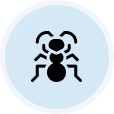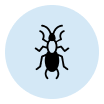Dust mites are household pests that sneak in unnoticed. These tiny creatures can trigger allergies and worsen asthma, posing a hidden menace. This fact sheet provides vital information about dust mites, including their life cycle, origin, signs of presence, and potential health impacts. Most importantly, we’ll explore effective ways to eliminate them from your home.
Curious? Read on to evict these tiny tenants.
Key Takeaways
- Dust mites, microscopic pests that thrive in warm, humid climates, can impact human health by triggering allergies and respiratory conditions, including asthma.
- Signs of dust mite infestation include exacerbated allergy symptoms, like runny nose, especially upon waking or in bed, and rapid dust accumulation after cleaning.
- Dust mites can be controlled through regular and thorough cleaning, using dust mite covers, controlling home humidity, using HEPA filters, steam cleaning, and opting for hard flooring and non-fabric furniture.
What Are Dust Mites?
Dust mites (Dermatophagoides pteronyssinus) are microscopic arachnids (yes, they’re related to common spiders) that usually inhabit homes, specifically in areas with abundant dead skin cells. They’re nearly invisible to the naked eye, measuring about 0.2–0.3 millimeters in length. Despite their small size, their effects are significantly profound, especially for allergy sufferers.
Dust mites thrive in warm, humid, and softer environments, such as bedding, upholstered furniture, and carpets. They feed on the dead skin cells that humans and pets shed daily, making your home a perfect buffet for them.
Unlike other pests, dust mites do not bite or sting. However, they can still pose a major health risk, particularly for people with respiratory ailments due to dust mite allergens.
What Is the Life Cycle of Dust Mites?
The life cycle of dust mites comprises four stages: egg, larva, nymph, and adult. The process starts when a female dust mite lays eggs, which hatch into larvae after approximately one week.
The larvae are six-legged creatures that morph into eight-legged nymphs after several days of feeding on dead skin cells. The nymph stage, which includes two molts, lasts about two weeks before they transform into mature adult dust mites.
Adult dust mites have a lifespan of about two months, during which females lay eggs continuously, ensuring a constant population in your home.
This rapid life cycle and the large number of laid eggs underscore why dust mite populations can grow exponentially in a short period. It’s also the primary reason for immediate intervention to ensure that the population is controlled.
Where Do Dust Mites Come From?
Dust mites are ubiquitous, which means they are found almost everywhere worldwide. They originate from outdoor environments but easily find their way into homes through windows, doors, and on people and pets, leading to an abundance of house dust mites.
Once inside, these microscopic creatures settle in places with abundant food supply (i.e., pet and human skin cells and dander) and optimal environmental conditions; specifically, warm and humid areas like bedding, upholstered furniture, and carpeting.
How Do Dust Mites Spread?
The spread of dust mites within and between homes primarily through dust movement. When dust is disturbed (for example, during cleaning), dust mites can become airborne and settle in other parts of the house, increasing their distribution.
They can also hitch a ride on people and pets or be transported on clothing, furniture, and other objects when moving from one place to another. Remember, controlling dust in your home is a significant step in managing dust mite populations.
What Are the Signs of Dust Mites?
Although invisible to the naked eye, dust mites can manifest their presence through various signs. Recognizing these early indicators can assist in their effective management and eventual elimination:
- Health-related indications: A sudden onset of allergic symptoms, like sneezing or runny nose. Or exacerbated skin conditions such as eczema and unexplained rashes.
- Sleep disturbances: If you experience intensified symptoms or discomfort during sleep or immediately upon waking, it could hint at dust mites’ activity in your bedding.
- Dust accumulation: A consistent presence of dust can provide a favorable environment for dust mites, as they thrive on the dead skin cells often found in household dust.
- Furniture & old items: Introducing second-hand furniture or retrieving older stored items could be a gateway for dust mites. It’s essential to inspect such items routinely to ward off potential infestations.
One can better manage dust mite populations by staying proactive and attentive to these signs, ensuring a healthier living environment.
What Are the Health Impacts of Dust Mites?
The health impacts of dust mites primarily revolve around allergies and respiratory issues. Dust mites excrete feces, which contain enzymes and proteins. When these are inhaled or come into contact with the skin, they can cause allergic reactions in susceptible individuals.
Prolonged exposure to dust mites may lead to the development of chronic conditions such as allergic rhinitis and asthma. Symptoms include:
- Sneezing
- Runny or itchy nose
- Red or watery eyes
- Coughing
- Postnasal drip
- Nasal congestion
- Difficulty breathing
- Asthma attacks (in extreme cases)
Symptoms are often more severe in the morning due to dust mites’ prevalence in bedding and mattresses.
Moreover, dust mites can also exacerbate skin conditions like eczema. People with dust mite allergies often experience skin rashes, itching, and inflammation, particularly after direct contact with infested bedding or clothing.
In essence, dust mite infestations can significantly impact the quality of life, leading to poor sleep, discomfort, and chronic healthcare conditions if not addressed promptly. Therefore, it is crucial to understand and implement efficient pest control measures to manage and eliminate dust mite populations.
How to Get Rid of Dust Mites
Combating dust mites requires both regular interventions and strategic choices for your home. Here are the top methods to reduce their numbers:
- Regular Cleaning: Vacuum carpets, rugs, and upholstery and wash bedding in hot water weekly to reduce dust mites.
- Dusting Techniques: Dust with a damp cloth to prevent dust mites from becoming airborne.
- Mattress and Pillow Protection: Use washable dust mite covers to encase mattresses, pillows, and duvets. These barriers prevent dust mites from settling in your bed.
- Manage Humidity: Dust mites thrive in humid environments. Use a dehumidifier or air conditioner to keep the humidity level in your home below 50%.
- HEPA Filters: Incorporate HEPA (High-Efficiency Particulate Air) filters and high-filtration vacuum cleaners in ventilation systems. These filters trap dust mites, preventing them from circulating in the air.
- Steam Cleaning: Use a steam cleaner on carpets and upholstery. The high temperatures kill dust mites. Ensure items are thoroughly dried afterward to prevent a favorable environment for mites.
- Pet Toy Treatment: Freeze soft toys of pets overnight to kill off dust mites.
- Home Furnishing Choices: Consider replacing carpets with hard flooring options like linoleum and choose leather or vinyl furniture over fabric upholstery. Dust mites find it more challenging to populate these surfaces compared to conventional soft furnishings.
By diligently incorporating these strategies into your routine, you can significantly reduce the dust mite population in your home.
 1st pest control service just $49. Must schedule service online.
1st pest control service just $49. Must schedule service online.






 You’re supporting a small, local business
You’re supporting a small, local business


